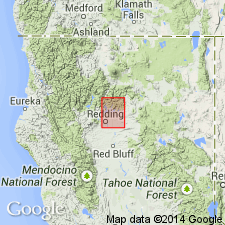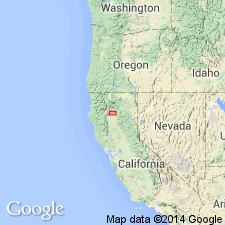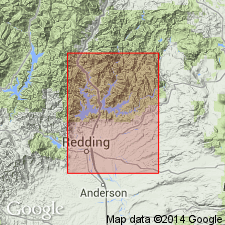
- Usage in publication:
-
- Bully Hill rhyolite
- Modifications:
-
- Original reference
- AAPG geologic province:
-
- Klamath Mountains province
Summary:
In Bully Hill region [Shasta County] the rhyolite is arranged in flows alternating with tuffs dipping southeast beneath the Pit shales, but in places it cuts lower part of Pit shales and envelops its fragments. For convenience all the rhyolites erupted in Redding quadrangle during deposition of Pit shales are included under term Bully Hill rhyolite, though they represent a considerable range of time. Bedded tuffs, composed largely of crystal fragments of quartz and feldspar, with a smaller proportion of glass and pumice particles replaced by quartz, are common among the Pit shales and are locally associated with sheets of rhyolite. Thickness about 500 feet. Age is Jurassic(?). Present in Redding quadrangle, northern California.
Source: US geologic names lexicon (USGS Bull. 896, p. 292-293).

- Usage in publication:
-
- Bully Hill rhyolite†
- Modifications:
-
- Abandoned
- AAPG geologic province:
-
- Klamath Mountains province
Summary:
Pg. 81-85. Proved this formation to be intrusive alaskite porphyry, and same as so-called "Balakala rhyolite." Both geographic names have therefore been discarded as unnecessary. The rock cuts formations as young as Pit shales (Middle and [Late] Triassic).
Source: US geologic names lexicon (USGS Bull. 896, p. 292-293).

- Usage in publication:
-
- Bully Hill rhyolite*
- Modifications:
-
- Reinstated
- Dominant lithology:
-
- Rhyolite
- AAPG geologic province:
-
- Klamath Mountains province
Summary:
Name Bully Hill rhyolite restored as formal stratigraphic unit [and adopted by the USGS]. Formation considered largely extrusive soda rhyolite and soda rhyolite porphyry rather than intrusive alaskite and alaskite porphyry (as it was considered by Graton who abandoned the name in 1910). Thickness (in Afterthought mine) about 1,110 feet. Lies in apparent conformity between older Dekkas andesite and younger Pit formation. Age is Middle and Late Triassic.
Source: US geologic names lexicon (USGS Bull. 1200, p. 532).

- Usage in publication:
-
- Bully Hill rhyolite*
- Modifications:
-
- Overview
- AAPG geologic province:
-
- Klamath Mountains province
Summary:
Pg. 12. Noted as being in fault contact with Pit formation near Afterthought mine.
Source: US geologic names lexicon (USGS Bull. 1200, p. 532).
For more information, please contact Nancy Stamm, Geologic Names Committee Secretary.
Asterisk (*) indicates published by U.S. Geological Survey authors.
"No current usage" (†) implies that a name has been abandoned or has fallen into disuse. Former usage and, if known, replacement name given in parentheses ( ).
Slash (/) indicates name conflicts with nomenclatural guidelines (CSN, 1933; ACSN, 1961, 1970; NACSN, 1983, 2005, 2021). May be explained within brackets ([ ]).

